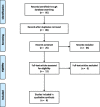Influence of uncontrolled diabetes mellitus on periodontal tissues during orthodontic tooth movement: a systematic review of animal studies
- PMID: 28133716
- PMCID: PMC5292324
- DOI: 10.1186/s40510-017-0159-z
Influence of uncontrolled diabetes mellitus on periodontal tissues during orthodontic tooth movement: a systematic review of animal studies
Abstract
Diabetes mellitus (DM) may adversely affect periodontal tissues during orthodontic tooth movement (OTM). The aim of this review is to systematically analyze and review animal studies investigating the effect of DM on periodontal tissues during OTM. An electronic search was conducted via PubMed/Medline, Google Scholar, Embase, ISI Web of Knowledge, and Cochrane Central Register of Controlled Trials (CONTROL) using the keywords "diabetes," "orthodontics," and "tooth movement" for studies published between January 2000 and August 2016. After elimination of duplicate items, the primary search resulted in 89 articles. After exclusion of irrelevant articles on the basis of abstract and title, full texts of 25 articles were read to exclude additional irrelevant studies. Seven animal studies were included in this review for qualitative analysis. When compared to healthy animals, more bone resorption and diminished bone remodeling were observed in diabetic animals in all studies. Furthermore, DM decreased the rate of OTM in one study, but in another study, DM accelerated OTM. DM may adversely affect bone remodeling and tooth movement during application of orthodontic forces. However, a number of potential sources of bias and deficiencies in methodology are present in studies investigating the association between OTM and DM. Hence, more long-term and well-designed studies are required before the exact mechanism and impact of DM on outcomes of orthodontic treatment is understood.
Figures
References
-
- Taylor GW, Manz MC, Borgnakke WS. Diabetes, periodontal diseases, dental caries, and tooth loss: a review of the literature. Giordano RA Compend Contin Educ Dent. 2004;25:179–184. - PubMed
-
- Taylor JJ, Preshaw PM, Lalla E. A review of the evidence for pathogenic mechanisms that may link periodontitis and diabetes. J Clin Periodontol. 2013;40(Suppl 14):S113–S134. - PubMed
Publication types
MeSH terms
LinkOut - more resources
Full Text Sources
Other Literature Sources


